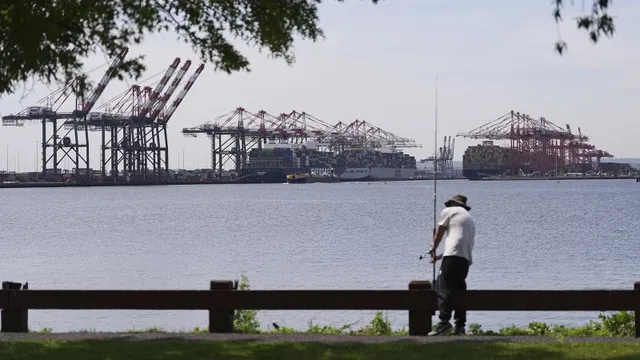
US economy shrinks 0.5% amid tariff fears and import surge
2025-06-30 00:00- The U.S. economy contracted at an annual rate of 0.5% from January to March 2025, marking the first quarterly decline in three years.
- This decline was largely due to a significant surge in imports, as companies rushed to secure foreign goods before impending tariffs.
- Economists expect a rebound in the second quarter of 2025, with growth predicted to bounce back to 3% as the impacts of tariffs stabilize.
Express your sentiment!
Insights
The U.S. economy experienced its first contraction in three years, shrinking by 0.5% annually from January to March 2025. This decline was primarily attributed to the disruption of business caused by President Donald Trump's trade wars, which prompted a surge in imports as companies rushed to stockpile foreign goods ahead of impending tariffs. In comparison, the economy had grown by 2.4% in the previous quarter. The overwhelming influx of imports, which rose by 37.9%, negatively impacted the gross domestic product (GDP) by nearly 4.7 percentage points. Consumer spending also slowed significantly during this period, indicating a shift in purchasing behavior. Notably, consumer spending exhibited growth at only 0.5%, a sharp decline from 4% growth recorded in the last quarter of 2024, and reached its lowest level since the end of the COVID-19 pandemic. Meanwhile, federal government spending saw a notable decrease of 4.6%, representing the largest contraction in federal spending since 1986. These changes reflect growing concerns over economic health amid uncertainties related to trade policies and government fiscal actions. Despite the downgrades from the Commerce Department, economists maintain that the surge of imports was a temporary phenomenon and do not expect to see a repeat in the following April to June quarter. Economic forecasts suggest a rebound, with predictions of growth bouncing back to about 3%. Several economists view the initial jump in imports as a strategic response by businesses to mitigate the immediate effects of tariffs. Companies took proactive measures, such as diversifying supply sources and adjusting inventory levels, to delay the impact of higher import costs as tariffs were set to take effect. Government and consumer behavior adjustments are expected to shift in response to these tariffs down the line. The final assessment of GDP for the first quarter deemed the inaccurate previous estimates troubling, leading some analysts to caution against concluding that the expected second quarter growth signals a recovery in the overall economy. Retail sales data, housing market trends, and labor market metrics indicate weakening economic activity. Analysts and economists are particularly focused on upcoming releases of personal consumption expenditures metrics as they seek to better gauge overall household spending patterns in the context of rising inflation pressures. With the expected economic rebound, it remains essential to closely monitor how increased import levels might influence consumer demand and the broader economic landscape moving forward.
Contexts
The impact of trade wars on the U.S. economy has been a subject of extensive analysis, particularly in the context of the ongoing economic shifts observed by 2025. The dynamics of international trade relations have seen significant transformations over the past few years, and trade wars have emerged as a critical factor influencing economic stability, growth, and employment rates. The imposition of tariffs and trade barriers has not only disrupted established supply chains but has also led to increased costs for consumers and businesses alike. As a result, industries that rely heavily on imported goods, such as manufacturing and retail, have faced marginal profit margins and, in some cases, substantial operational challenges. Furthermore, retaliatory measures from trading partners have exacerbated tensions, hindering potential economic collaborations and trade agreements that might otherwise benefit the U.S. economy. By 2025, the long-term effects of these trade wars have arguably solidified into a nuanced economic landscape. While certain sectors, particularly those involved in domestic production, have seen a temporary boost due to a focus on local sourcing, the overall economic impact may be detrimental. Increased production costs have pressured manufacturers to either absorb expenses or pass them down to consumers, thus leading to inflationary pressures. This has particularly affected lower-income households as essential goods have become more expensive, striking at the heart of consumer purchasing power. Moreover, with rising prices across various commodity markets due to disrupted imports, consumers have less disposable income to engage in broader economic activities, which further strains economic growth. As the U.S. navigates these complex trade relationships, it becomes increasingly crucial to consider the geopolitical ramifications of trade wars. The strategic partnerships and alliances that once defined U.S. economic relationships are now tarnished, leading to a possible decline in the country’s global influence. Additionally, businesses are compelled to reconsider their international strategies and supply chain logistics, often seeking alternative markets or investing in domestic capacities to mitigate risks associated with tariff-induced uncertainty. These shifts may foster innovation and a renewed focus on local products, yet the transition comes with significant challenges, asking for a rethink of entitlement policies and investment in workforce development. Looking to the future, it is imperative for policymakers to find pathways toward diplomatic negotiation and conflict resolution in trade disputes. Reducing tariffs and fostering open markets could lead to regained economic momentum and stability. Proactive measures that support affected industries and workers, such as retraining programs and subsidies, could provide a buffer against the negative impacts of trade wars. A balanced approach that prioritizes both national interests and commitment to international cooperation will be necessary for the U.S. economy to thrive in a complex global marketplace. As we move forward, reflecting on the experiences of the past years can guide the creation of a more resilient and prosperous economic environment.